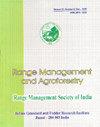Nutritional assessment of Ziziphus mucronata leaves as protein supplements in grass (Eragrostis spp.) hay basal diets
IF 0.8
4区 农林科学
Q3 AGRONOMY
引用次数: 0
Abstract
The study investigated the effect of supplementing a grass (Eragrostis spp.) hay basal diet with Ziziphus mucronata leaf meal (ZLM) on chemical composition and in vitro ruminal fermentation with or without the aid of polyethylene glycol (PEG). The grass hay was supplemented with ZLM at a rate of 0 (ZM0), 5 (ZM5), 10 (ZM10), 15 (ZM15), 20 (ZM20) and 25% w/w (ZM25). Positive linear trends (P<0.05) were observed for dry matter (DM), crude protein (CP), soluble phenolics (SCT) and total soluble phenolics (TSPh), except for organic matter (OM) that linearly declined as ZLM levels increased. Neutral detergent fibre quadratically (P<0.05) responded to ZLM levels, but no significant trends were observed for acid detergent fibre and lignin. Treatment ZM25 had higher (P<0.05) CP, SCT and TSPh contents than the control treatment. The inclusion of PEG increased (P>0.05) cumulative gas production at 12, 24, 36 and 48 h post-inoculation. Supplementing the grass hay with ZLM had significant (P<0.05) influence on fermentation kinetics. The inoculation with PEG resulted in a negative quadratic trend for the partitioning factor at 96 h post-incubation [y = 326.0(±39.49) ̵ 20.01(±6.962)x + 0.785(±0.262)x2], from which an optimum ZLM supplementation rate was calculated to be 13%. It was concluded that ZLM can be used as a protein source, and with the aid of PEG, it can maximize ruminal fermentation efficiency of grass hay when included at 130 g/kg.紫茎叶作为草(Eragrostis spp.)干草基础日粮中蛋白质补充物的营养评价
本试验研究了在草(Eragrostis spp.)干草基础饲粮中添加聚乙二醇(PEG)和不添加聚乙二醇(PEG)对草(Eragrostis spp.)干草化学组成和体外瘤胃发酵的影响。以0 (ZM0)、5 (ZM5)、10 (ZM10)、15 (ZM15)、20 (ZM20)和25% w/w (ZM25)的比例添加ZLM。干物质(DM)、粗蛋白质(CP)、可溶性酚类物质(SCT)和总可溶性酚类物质(TSPh)除有机质(OM)随ZLM水平的升高呈线性下降外,其余均呈线性正趋势(P<0.05)。中性洗涤纤维对ZLM有二次响应(P<0.05),而酸性洗涤纤维和木质素无显著变化。ZM25处理CP、SCT和TSPh含量均高于对照处理(p < 0.05)。在接种后12、24、36和48 h, PEG的加入增加了累积产气量(P>0.05)。草料中添加ZLM对发酵动力学有显著影响(P<0.05)。接种PEG后96 h,分配因子呈负二次型趋势[y = 326.0(±39.49)20.01(±6.962)0.785(±0.262)x2],由此计算出ZLM的最佳补充率为13%。综上所述,ZLM可作为蛋白质源,在PEG的辅助下,添加量为130 g/kg时,草干草瘤胃发酵效率最高。
本文章由计算机程序翻译,如有差异,请以英文原文为准。
求助全文
约1分钟内获得全文
求助全文
来源期刊

Range Management and Agroforestry
AGRONOMY-
CiteScore
1.50
自引率
62.50%
发文量
25
审稿时长
>12 weeks
期刊介绍:
The Society has been established with the following objectives:
1. To advance the cause of research activity in all aspects of rangelands and to encourage and promote the studies on rangeland, wasteland ecosystems and agroforestry.
2. To provide facilities for seminars and conferences to rangeland researchers, development workers and farmers and to encourage close cooperation with organizations having related aims and interests.
3. To disseminate the knowledge of scientific agriculture and technology for forage and rangeland production, improvement and management.
 求助内容:
求助内容: 应助结果提醒方式:
应助结果提醒方式:


